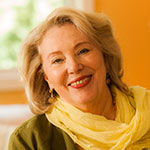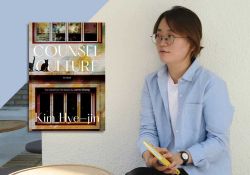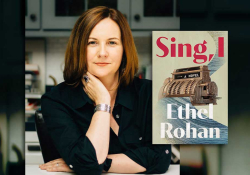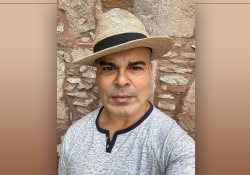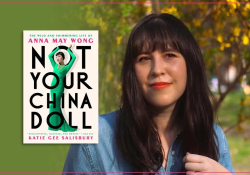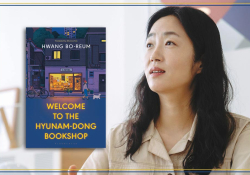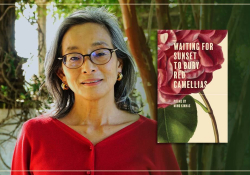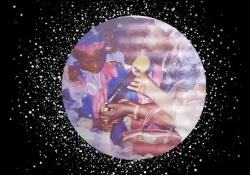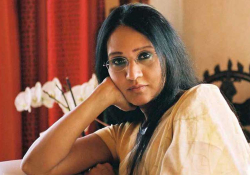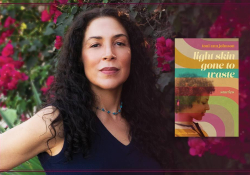“Suffering Memory”: The Unseen Worlds of Marilène Phipps
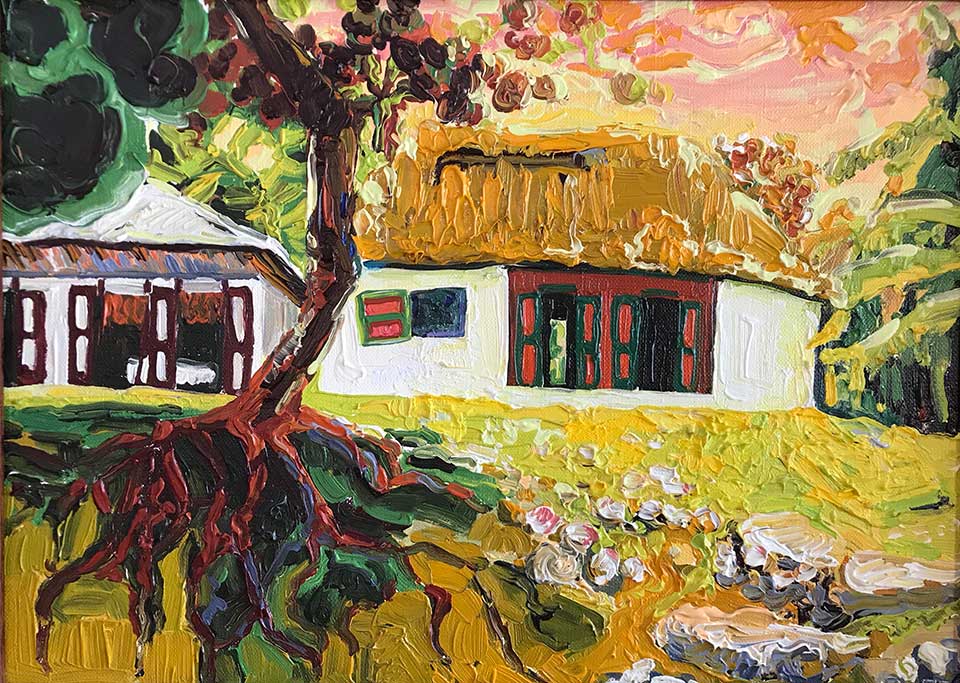
Whether she is a writer who paints or a painter who writes, Marilène Phipps combines the two gifts with a rare brilliance and always with a bold appreciation of her Haitian homeland. Born to a French mother and Haitian father, she grew up under the Duvalier dictatorship. She studied anthropology at the University of California, Berkeley, and received an MFA in painting from the University of Pennsylvania. Her poetry collection Crossroads and Unholy Water (2000) won the Crab Orchard Prize, and her short-story collection The Company of Heaven (2010) won the Iowa Short Fiction Award. She edited Jack Kerouac’s Collected Poems (2012) for the Library of America. Mixing realism with expressionism, her paintings are sought after in galleries and private collections throughout the world. Phipps has held fellowships at the Guggenheim Foundation and Harvard University’s Du Bois Research Institute. In her powerful memoir, Unseen Worlds: Adventures at the Crossroads of Vodou Spirits and Latter-day Saints (Calumet Editions 2018), readers meet Phipps’s extended Haitian family, including rebels fighting against the dictatorship, relive the nightmare of the earthquake of 2010, and share her journey with spiritual leaders and practitioners associated with Vodou, Catholicism, and the Mormon faith.
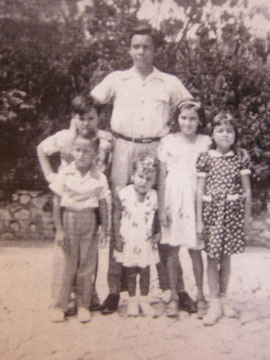
“Guslé is the tall one (thirteen years old).
Directly under his arms are his brother
(not mentioned by name because he would not allow me to),
and his sister Louise. Cousin Therese is right next to Louise.
I am the smallest one in the picture, in front of Guslé’s legs.
My brother Gaëtan is to my right, in front of Guslé’s brother.” /
Courtesy of the author
Renee Shea: You dedicate the memoir to Guslé Villedrouin, your cousin and godfather, and he seems the unbroken circle of the memoir’s structure. In what ways might Unseen Worlds be read as a tribute to him?
Marilène Phipps: I dedicate the book to Guslé because the book is about a spiritual journey. Guslé was my godfather—my father before God. I saw his brief journey through life as a deeply spiritual journey. The great gesture he made with his life was his legacy to the family, to the world, and to me. It impacted me in ways that I cannot fully evaluate. While Guslé’s story is interwoven throughout the book, I do think that it is my brother Gaëtan who opens and closes the book. His significance is familial and emotional—he is my brother, the closest being genetically to me, we grew in the same womb, we shared the impact of childhood.
Guslé’s significance in my life is more spiritual. At first glance, his story appears simple, even if tragic. Guslé gave his life to try and topple the Duvalier dictatorship in Haiti. At twenty-four, he became the head of a group of thirteen rebels in New York who decided to overthrow “Papa Doc” Duvalier. They planned it, received military training, and got armed. They landed in the south of Haiti in Dame-Marie, near Jérémie. They had, however, already been betrayed. Duvalier therefore expected them. They understood this right away after landing and were able to take to the mountains of L’Asile, where they hid and fought the whole of the Duvalier army for two months until they ran out of munitions. The rumored legend has it that Guslé was the last to die. The selflessness involved in giving one’s life to save others indicated an unusual spiritual dimension.
Shea: You were an ardent student of and initiate into Vodou, yet when you became disenchanted, you even destroyed some of your paintings because you said you did not want them to represent you, to be your legacy. Why?
Phipps: These paintings had traveled to many US galleries in one-woman shows under the title Altars and Shrines of Haiti. I had wanted to examine and glorify the universality of the human spiritual impulse, the immense imagination at play in diverse cultures to devise a way to explain God and make contact with him. I also wanted to present Haitian people with the dignity and honor they deserve in a world where there are still so many negative stereotypes associated with anything coming from black people, whether their skin, hair, language, culture, or religion.
In the end, destroying these paintings may seem like I defeated my own purpose, an acknowledgment that I had been wrong. But I saw that the paintings could be interpreted as visual statements of where I stood on spiritual grounds, which spiritual life I value, a pointing of the way toward a belief system I endorsed. I did not want to make that statement because that was not where I stood in terms of my spiritual beliefs, these Vodou spirits were not the God by whose side I stood, and so I “shut them up” by destroying them.
I had initially studied Vodou as an anthropologist. My desire to change the world’s negative stereotypes was an intellectual and emotional stance, not a religious one. I had put myself in situ to find out objectively what was going on, to understand and cherish the country in which I had been born and grew up. But I had grown to understand better the deep dangers to the soul found in the Vodou worship system.
Shea: Much of the memoir is taken up with history, though presented in different ways—at times like a historical record, other times through “remembered” conversations. How much of your decisions about what to include was influenced by the readers you had in mind?
Phipps: It is impossible to really know who one’s readers might be. So, ultimately, the prototypical reader is oneself. I did a lot of research for the historical parts—Haiti’s history or Catholic Church history—and tried to present them in various fun ways. What and how much to include is what needs to be included so that the unfolding of history makes sense, or so an argument holds. I removed everything else. It is easy to overwrite and tire the reader. That’s a deadly thing because the reader won’t make it to the end—which is essential. Not reading a book to the end is like cutting a slice out of a whole. I daresay that my last chapter is my best.
Shea: In your conversation with Guslé’s sister Louise, you say, “Memory is a strange thing . . . an ally or an aggressor, depending on what comes up.” You kept a diary, but that began fairly recently. You recount talking with Guslé’s mother, and I assume there were others with whom you(re)connected. How did you “remember” and put together the memories that are critical to Unseen Worlds?
All artists, poets in particular, have spoken of the sense of being used by something indescribable. I have had whole poems just pour out of me.
Phipps: I have sometimes said laughingly about myself that I “suffer from memory.” My cousins are astonished at all that I remember of our childhood. It comes in handy for me as a writer . . . so the word “reconstruct” is a good one in referring to the long conversations. And, you know, all artists, poets in particular, have spoken of the sense of being used by something indescribable. I have had whole poems just pour out of me. I think that Whitman spoke about that feeling too. As a painter I also have mentioned the sense of being surprised in the morning by what I had painted the day before.
But writing about Guslé, it was different. I first wrote about him in “Dame Marie,” a story in The Company of Heaven. I got the news of winning the Iowa Prize and the news of the earthquake in Haiti the same afternoon on my phone messages. Later on, I meant to do a whole book about Guslé. I wanted to study, and hopefully reveal, the secrets of the upbringing and psychology of a man willing to die for others, as selflessly as Christ. When and how do the signs become visible? I visited my aunt and Guslé’s sister in Florida. I studied family documents. I asked them endless questions. They were moved. They were patient. We cried. They did not remember as much as I hoped.
I was six years old the last time I saw Guslé. I therefore knew him little. I have images of him in certain places of our grandmother’s garden. I remember the sound of my name in his voice—deep and warm. All considered, my attachment to Guslé is somewhat mysterious. And when all was said and done, I had to admit that I could not write the book I wanted to. I am not a historian. I am not inclined to the meticulous fact-finding and ordering necessary for writing history. Besides, Guslé’s story could already be found in many books. I ended up approaching my cousin’s spirit the only way I could—as a poet—to feel him more than study him.
Shea: You write, “The earthquake [of 2010] has become a large metaphor in my life.” In what ways is Unseen Worlds an exploration of that metaphor?
Phipps: Earthquakes leave devastation behind. One’s life can generate the same feelings in one’s heart. In writing Unseen Worlds, I explored through the destruction of all that had been familiar and loved, I examined the sense of waste of all that was lived and held onto, I was forced into a letting go. And then that same exploration confronted me with the need to rebuild. There are choices suddenly available that one never had before. Construction need no longer be the result of haphazard survival solutions.
Earthquakes leave devastation behind. One’s life can generate the same feelings in one’s heart.
Shea: You describe yourself as mahogany: “I am mahogany, an indigenous West Indian breed, and a U.S. import.” Later, “I am the mahogany in God’s garden.” Does that metaphor still capture how you see yourself?
Phipps: Yes, in a way. But that metaphor does not cover all the ways in which I see myself, or all that I am. The working title of the book had been Mahogany. It was because of the numerous mahogany trees my father planted in the garden where I grew up. Our house was paneled with mahogany, with mahogany doors, windows, beds, tables, chairs, etc. Mahogany was “home.”
Shea: The spiritual quest at the heart of Unseen Worlds seems rooted in the desire to belong. You describe the “feeling of connection to the divine as well as to the larger Haitian family and culture” that for a time Vodou gave you. Your attraction to the Church of the Latter-Day Saints feels very similar. So have you found your family, your home, now?
I believe that my essential quest was, is, for a connection to the divine.
Phipps: For a person in exile, by force or by choice, being moved by the desire to belong is not unusual. I bought a house last year, and I counted this as the thirty-ninth move of my life. I think that I am used to not belonging. In a way, this gives a strange freedom to the mind. There are pressures to conform in our place of birth weighing greater than elsewhere we might go. I believe, however, that my essential quest was, is, for a connection to the divine rather than to belong to a larger family. One could argue that the Catholicism of my birth and early years offered me a large family of saints, a mother and a father.
My ultimate attraction to and choice of the Church of Jesus Christ was theological. Adapting and finding my place within the American Latter-day Saints’ subculture was challenging. Fortunately, they are a deeply kind and welcoming people. They do their best to make you feel part of a larger family. However, the whole body of the church is there only to promote and help each person develop a personal relationship with God. The church is everywhere in the world right now. The uniting principle is the theology or scripture-based doctrines. Ultimately, home is with God. So yes, I have found my home.
Shea: Would you say that the tarantula that family legend claims took up residence in your crib when you were an infant is gone?
Phipps: Satan as tarantula has been banished! But you know, he may still try . . . It’s okay to be tested. But I would love to see the tarantula as a wondrous creature of my exotic childhood walk across my living room right now.
Shea: You write that “spiritual growth is an aquatic tree.” Is the tree still thriving, changing?
Phipps: Continuously. Astonishingly so. In converting to the Church of Jesus Christ of Latter-day Saints, I admit that I took a leap of faith. I did not know fully what I was doing. I figured that if it did not help, it would not hurt. I was invited to an adventure that seemed luminous and strengthening, and I accepted the invitation. I now think that to take a leap of faith is the only way. Each experience is so personal that there is no way to predict what will happen, or how it will. What is certain is that only good will happen in a commitment to the Church of Jesus Christ. You have to put yourself in situ if you want spiritual growth. But there is danger to the soul in the wrong church. My luck was that this is the right place, the only place, the true place. I feel that I was protected and led. Ultimately, we all are. Just listen to the inner voice. Learn to hear what silence tells you.
February 2019
